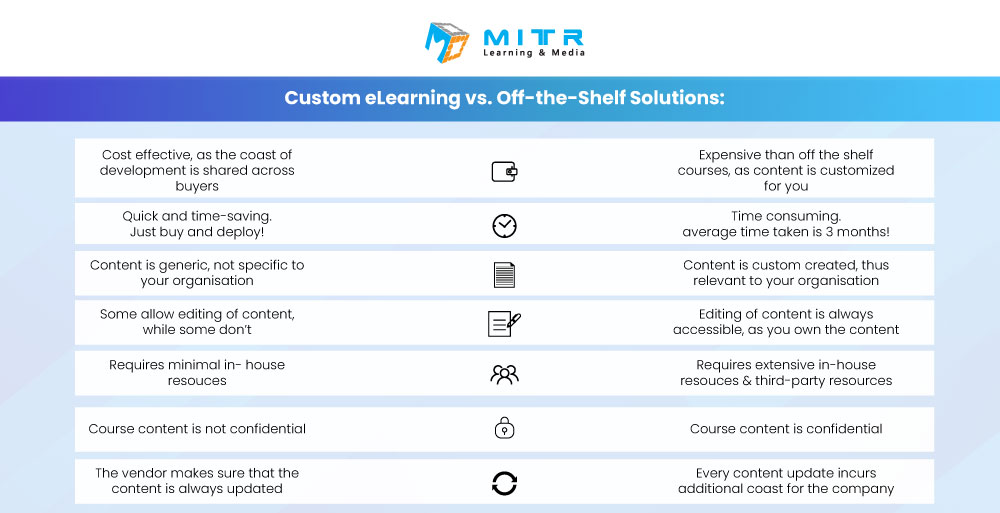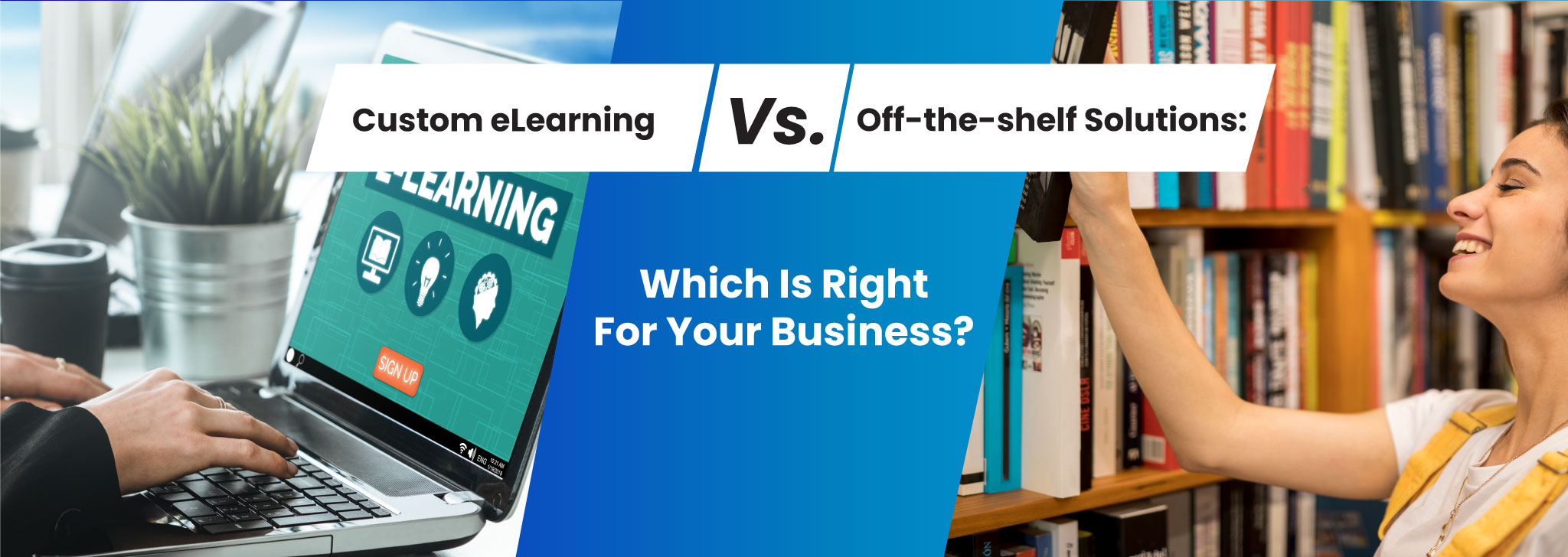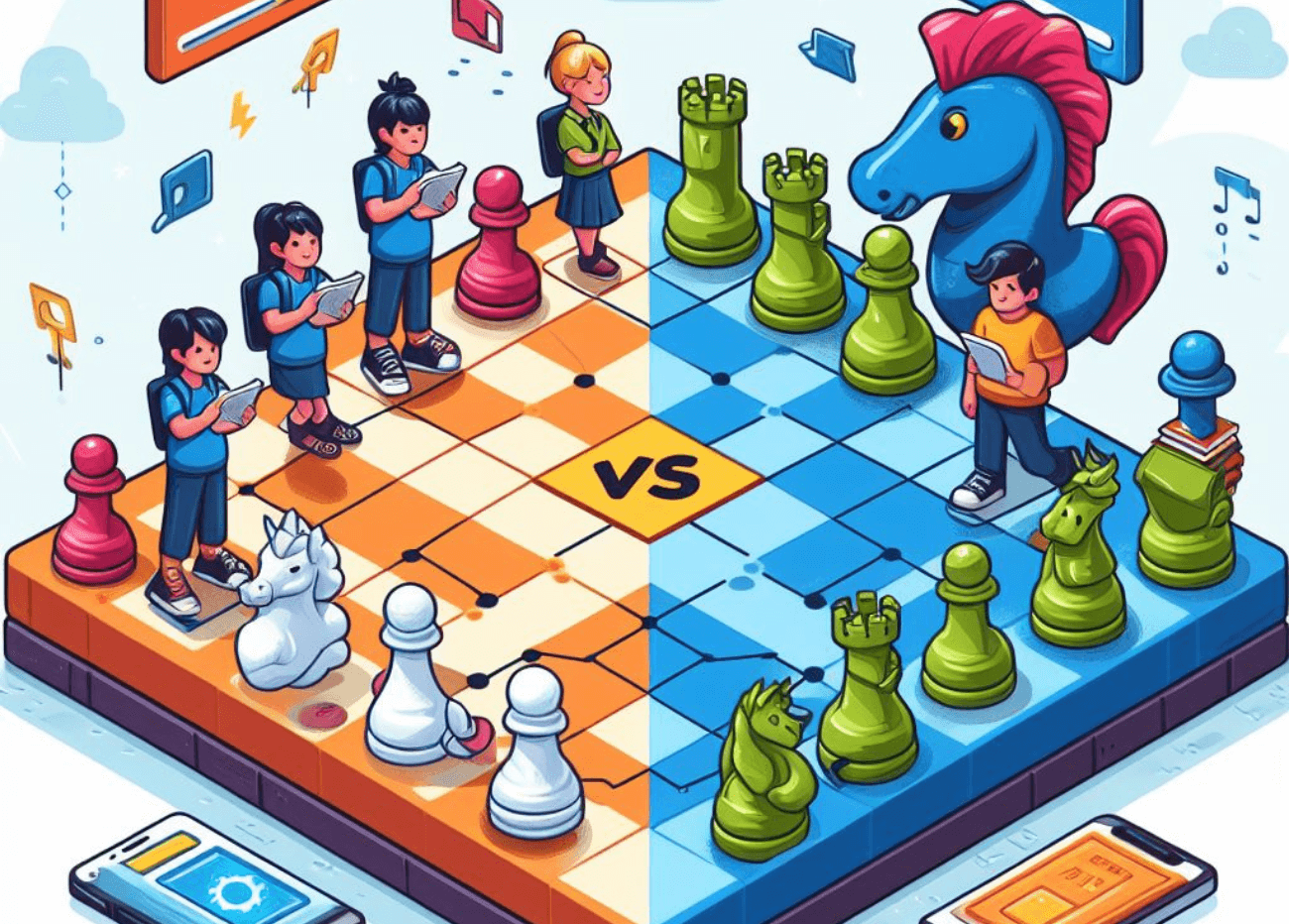Custom eLearning vs. Off-the-Shelf Solutions: Which is Right for Your Business?
Conventional classroom -based learning methods are being complemented by eLearning solutions that can be accessed from anywhere at any time. Organizations have the option to choose between off-the-shelf or custom elearning development solutions, each with its own set of advantages and drawbacks.
This article provides an unbiased comparison between off-the-shelf and custom eLearning solutions, highlighting unique advantages of each elearning development solutions in accordance with specific business requirements. We aim to be unbiased while discussing pros and cons related to both approaches that should help you choose what is best for your training needs and is easily integrated into your company’s operations.
What is Custom eLearning?
Custom eLearning involves deploying tailored learning materials and solutions specifically designed and developed to meet the unique needs, culture, processes, and training objectives of a particular organization. Unlike off-the-shelf eLearning courses, custom eLearning solutions are made from scratch, without using pre-existing templates.
Custom eLearning can encompass a wide range of content, such as regulatory training, industry-specific knowledge, soft skills development, onboarding programs for new employees, and safety protocols. Such initiatives promote business growth because they do not just train but also contribute positively towards other facets of company success. Custom eLearning can be easily adapted, modified, or transformed so as to align with the evolving needs of businesses.
Custom eLearning interventions become effective strategic enablers enhancing employee experience resulting in improved performance towards achieving desired outcomes.
Custom eLearning solutions can incorporate diverse media formats, including live-streamed and pre-recorded videos, interactive online modules, simulations, games, tests, quizzes, and PDFs, allowing for direct engagement and a dynamic learning experience.
It is possible to design the course to fit any needs or preferences companies might have. Unlike off-the-shelf solutions, custom eLearning provides organizations with complete control over the content, enabling them to create lessons that accurately address their specific learning requirements.
Though developing custom eLearning solutions may be challenging it is worthwhile to create lessons tailored to your business’s unique needs. The adaptability of custom eLearning enables organizations to continuously evolve and expand their learning materials as their requirements change over time.
Thus Custom eLearning solutions also known as custom eLearning development offer the option to adapt, adjust and even completely revamp course content according to an organization’s specific requirements.
When To Use Custom eLearning Courses?
In custom designed courses, businesses can have their brand integrated into the course through illustrations, colors, company specific simulations and business scenarios. Companies can narrate their stories effectively by designing elements like concept illustrations and company branding that are unique to them. This makes the content more relevant even as it reinforces brand identity throughout the course.
What is Off-The-Shelf eLearning?
Off-the-shelf e-learning content refers to pre-developed training materials that can be readily purchased or licensed from eLearning content providers. These pre-packaged courses are designed as comprehensive solutions, offering cost-effective options for general training requirements. Although they may be white-labeled and slightly personalized; they are not tailored for specific organizational requirements or easily integrate with other technologies.
Off-the-shelf eLearning content typically covers generic subjects applicable across different industries and organizations with a wide target audience. These ready-to-use courses cover a wide range of topics using diverse multimedia elements such as videos, interactive features, animations, games simulations, quizzes and PDF documents.
These courses are designed by Subject Matter Experts (SMEs), industry professionals, and skilled Instructional Designers. Preformatted off-the-shelf e-learning content is an easy fit into most Learning Management Systems (LMS) allowing fast deployment of learning programs.
When Can Off-The-Shelf Courses Be Used?
Off-the-shelf eLearning content is best suited for training that requires generic content. Individuals studying for exams or certifications that require comprehensive information would find off-the-shelf courses beneficial. Off the shelf content is useful when the content requirement is based on the following:
- Universal – When the required training content is universal and generic, off-the-shelf content training is ideal. Courses covering broad topics like negotiation, team building, or compliance training offer informative and widely applicable content without the need for costly customization.
- Time constraints – In urgent situations, off-the-shelf courses are effective. Being readily available, these pre-built courses can be quickly uploaded and deployed on a Learning Management System (LMS), making them a convenient option for addressing immediate training needs.
- Affordable – Off-the-shelf eLearning courses are often more affordable compared to custom-developed solutions as they are pre-made and do not necessitate additional resource investment. With licensing and associated costs distributed among many users, they provide a cost-effective solution for training needs.
Off-the-Shelf Courses vs. Customized E-Learning Content

| Customized E-Learning | Off-the-Shelf Courses | |
|---|---|---|
| Target Audience | Specific learning goals, audience characteristics, and organizational needs | Wide-ranging audience |
| Flexibility | Highly flexible, adapts to changing learner requirements | Limited flexibility, few customizable settings |
| Cost | More expensive due to development, design, and authoring | Less expensive due to shared development costs |
| Development Time | Longer due to content creation, reviews, and iterations | Faster deployment, requires minimal adjustments |
| Relevance | Highly relevant due to specific learning objectives and alignment with industry standards and organizational culture | May require adaptation or supplementation for specific needs |
| Scalability | Highly scalable to accommodate growth, changing technology, and increasing learner numbers | Scalable, but may require content updates for significant changes |
| Quality Control | High control over content quality, user experience, and instructional design | Quality can vary, some courses are outdated or less engaging |
| Ownership | Owned by the organization, allowing for unlimited modification | Joint ownership with the provider, limiting significant changes |
| Learning Experience | Individualized and immersive, caters to specific learner needs and preferences | Standardized experience, may not address all learning styles |
| Integration | Seamless integration with existing LMS and organizational workflows | May require additional configurations for integration with existing systems |
What Are Commercial Elearning Program’s Pros And Cons?
Off-The-Shelf Elearning Pros:
1. Quick Implementation
One reason why many organizations prefer off-the shelf learning materials is because they can be deployed rapidly and easily. By leveraging licensed content from content libraries and Learning Management Systems (LMS), this type of eLearning solution ensures immediate access to training resources.
2. It speeds up building Content Libraries
Off-the-shelf eLearning courses are an ideal choice for organizations embarking on their digital learning journey and allow for quickly populating virtual libraries, providing a comprehensive starting point for training initiatives.
3. Multiple Options
There are a plethora of choices for organizations looking for ready-to-use options.
4. Economical
When compared to custom development, off- the- shelf content generally poses lower upfront costs.. However, some aspects like number of users or users’ access may need to be factored in while considering total cost.
5. Multiple Language Provision
Many leading off-the-shelf vendors offer multilingual support for cross-border training initiatives albeit at an extra charge.
6. Convenience:
For teams of all sizes, these solutions provide the utmost convenience in terms of access to on-demand training materials.
Off-The-Shelf Elearning Cons:
1. Generic Content
One of the primary drawbacks of off-the-shelf eLearning content is its generic nature. As these courses are designed for mass consumption and cater to a wide audience, they often lack the necessary specificity and customization required to drive organization-specific behavioral change or enhance job-specific performance.
2. Licensing Expenses
Off-the-shelf content purchases usually require licensing fees which are calculated based on the number of users and can build up annually due to renewal requirements.
3. Inflexible Content
In a dynamically changing business environment, such e-learning material can become outdated or irrelevant over time. While some providers regularly update their content, others may have long refresh cycles leading to the dissemination of outdated information or practices.
Nonetheless, off-the-shelf eLearning remains a valuable option particularly for those organizations that need fast deployment and cost-effective training solutions.
Now let’s proceed into custom eLearning development with off- the –shelf alternatives to see if it has more merits than demerits.
What Are The Pros And Cons Of Custom Elearning?
Custom Elearning Pros:
1. You Own it:
Developing your own customized learning solution gives you complete ownership over all its components from tool selection to overall design.
2. Portrayal of Company Culture:
Customized learning can fully capture your unique corporate culture and personality rather than mere branding by immersing learners in an environment consistent with their organization.
3. Unrestricted Distribution:
There are no limitations on distribution or recurrent fees associated with customized solutions unlike off-the-shelf options; once developed, it can be scaled up based on the team’s needs for training.
4. Self-Maintenance:
The ability to update and maintain custom content after it has been delivered is unmatched. You can easily manage revisions and updates within your organization with the right authoring tools and know-how.
5. Accelerated Implementation:
While it may take time to build a custom eLearning solution in-house, partnering with an expert eLearning development partner can speed up the process significantly.
6. Economical in the Long Run:
Custom solutions can be initially costly, but they often lead to savings in the long run especially compared to recurring license fees associated with off-the-shelf alternatives.
Custom eLearning Cons:
1. Time Consuming Development Process:
Developing an eLearning course from scratch involves a meticulous process right from eLearning provider selection to project scoping, design, testing and implementation. This comprehensive approach means that the development cycle for custom content is longer.
2. Initial High Costs:
Big budgets are required for implementing custom solutions especially since these projects could last for years; however, long-term cost analysis indicates potential savings in comparison to off-shelf counterparts.
3. Active Involvement Essential:
While the technical side is managed by eLearning content developers, you must be constantly involved throughout the project’s lifecycle. Regular meetings, SME collaborations and content reviews call for consistent engagement particularly for complex initiatives.
So, Which Option Is The Best?
It depends on various factors such as business needs, learner preferences, budget and timeline making it difficult to choose between custom versus off-the-shelf e-Learning options . We urge you to review your specific requirements carefully so that you strike a balance between one-time costs and long-term gains.
Making the Right Choice
Both off-the-shelf and custom e-learning providers offer unique benefits and have drawbacks. Off the shelf material provides a fast and convenient choice when it comes to implementation but may fail to address an organization’s specific needs.
On the other hand, custom eLearning development entails designing courses that fulfill your requirements thereby creating a personalized learning experience mapped to your business goals. Even though it takes time, this customized approach ensures effectiveness, measurable outcomes and an enriching learning journey for your institution.
- Team Mitrhttps://www.mitrmedia.com/resources/blogs/author/team-mitr/
- Team Mitrhttps://www.mitrmedia.com/resources/blogs/author/team-mitr/
- Team Mitrhttps://www.mitrmedia.com/resources/blogs/author/team-mitr/
- Team Mitrhttps://www.mitrmedia.com/resources/blogs/author/team-mitr/





iac2012.org
Excellent post. I am dealing with many of these issues as well..